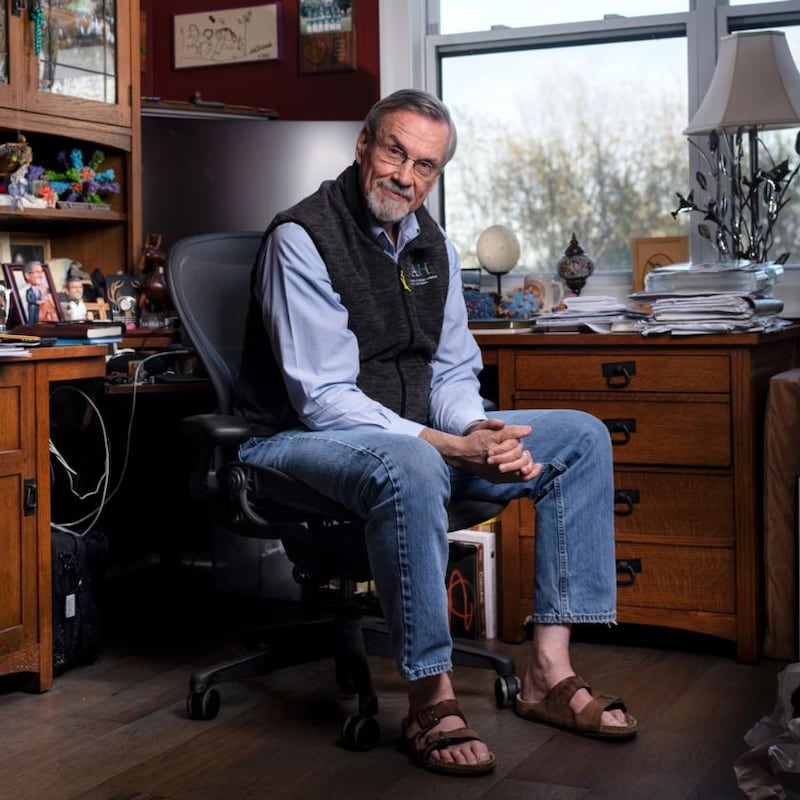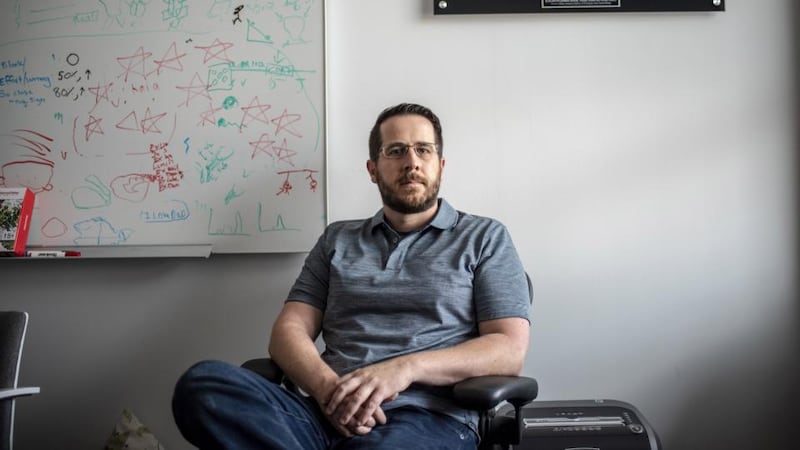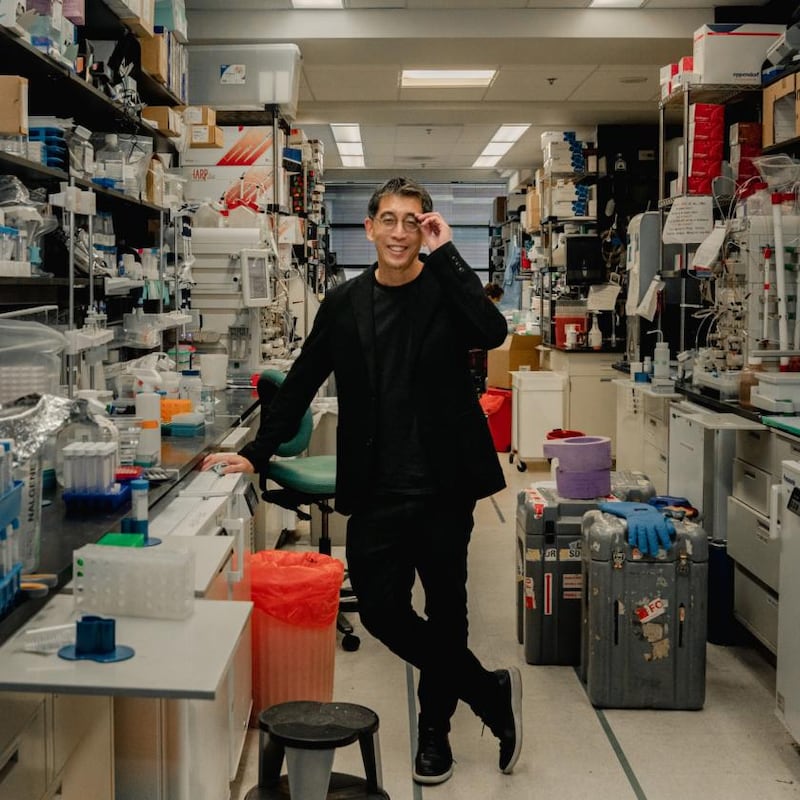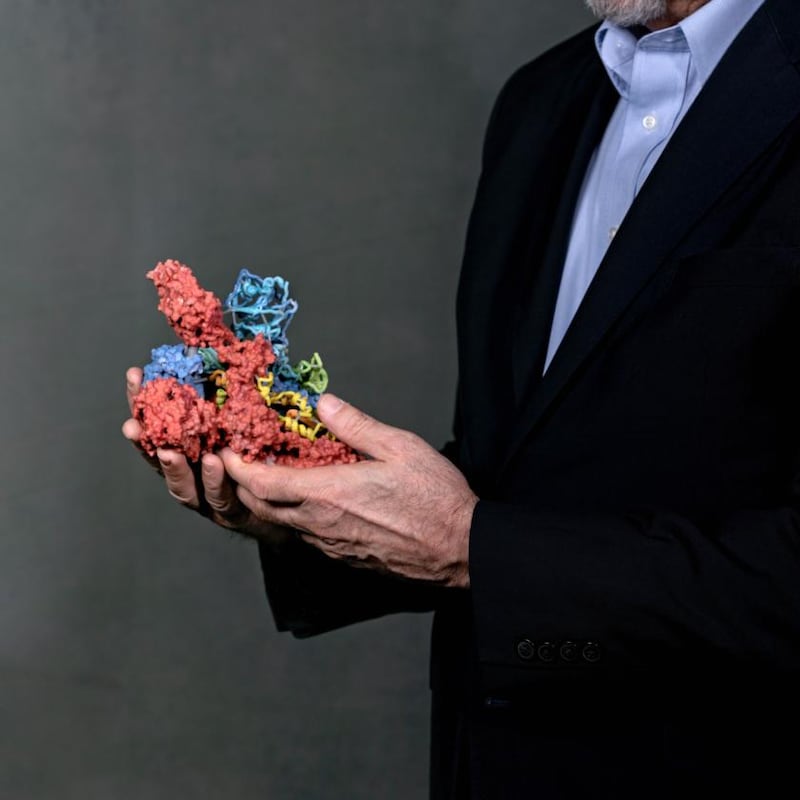Thousands of miles from Dr Barney Graham's lab in Bethesda, Maryland, USA, a frightening new coronavirus had jumped from camels to humans in the Middle East, killing 1 out of every 3 people infected. An expert on the world's most intractable viruses, Graham had been working for months to develop a vaccine but had gotten nowhere.
Now he was terrified that the virus, Middle East respiratory syndrome, or MERS, had infected one of his lab's own scientists, who was sick with a fever and a cough in autumn 2013 after a pilgrimage to the holy city of Mecca in Saudi Arabia.
A nose swab came back positive for a coronavirus, seeming to confirm Graham’s worst fears, only for a second test to deliver relief: It was a mild coronavirus, causing a common cold, not MERS.
Graham had a flash of intuition: perhaps it would be worth taking a closer look at this humdrum cold virus.
The decision to study a colleague’s bad cold gave rise to critical discoveries. Together with other chance breakthroughs that seemed insignificant at the time, it would lead eventually to the mRNA vaccines now protecting hundreds of millions of people from Covid-19.

They remain a marvel: Even as the omicron variant fuels a new wave of the pandemic, the vaccines have proved remarkably resilient at defending against severe illness and death. And the manufacturers, Pfizer, BioNTech and Moderna, say that mRNA technology will allow them to adapt the vaccines quickly to fend off whatever dangerous new version of the virus that evolution brings next.
Skeptics have seized on the rapid development of the vaccines to undermine the public’s trust in them. But the breakthroughs behind the vaccines unfolded over decades as scientists across the world pursued research in disparate areas, never imagining their work would one day come together to tame the pandemic of the century.
The vaccines were possible only because of efforts in three areas. The first began more than 60 years ago with the discovery of mRNA, the genetic molecule that helps cells make proteins. A few decades later, two scientists in Pennsylvania decided to use the molecule to command cells to make tiny pieces of viruses that would strengthen the immune system.
The second effort took place in the private sector as biotechnology companies in Canada searched for a way to protect fragile genetic molecules so they could be safely delivered to human cells.
The third crucial line of inquiry began in the 1990s, when the US government embarked on a multibillion-dollar quest to find a vaccine to prevent AIDS. That effort funded a group of scientists who tried to target the all-important “spikes” on HIV viruses that allow them to invade cells. The work has not resulted in a successful HIV vaccine. But some of these researchers, including Graham, eventually unlocked secrets that allowed the spikes on coronaviruses to be mapped instead.
Vaccines protect people by giving the immune system a preview of an invading microbe so it can prepare a strong defence against the real thing
In early 2020, these different strands of research came together. The spike of the Covid virus was encoded in mRNA molecules. Those molecules were wrapped in a protective layer of fat and poured into small glass vials. When the shots went in arms less than a year later, recipients’ cells responded by producing proteins that resembled the spikes – and that trained the body to attack the coronavirus.
In December 1996 US president Bill Clinton invited Dr Anthony Fauci to the Oval Office to brief him on that era's grave pandemic, AIDS, which by then had killed more than 350,000 people in the US and 6 million more globally.
As the men walked out to the Rose Garden, Fauci recalled, the president said, "You've known about AIDS as a disease since 1981. How come you guys don't have a vaccine yet?"
Fauci told the president that research efforts thus far had been largely uncoordinated. Then he made a bold pitch: a research facility where scientists from different disciplines could talk to one another and collaborate, with the goal of putting vaccines into arms.
Five months later, Fauci got a call from one of the president's speechwriters. Clinton was going to give a commencement address at Morgan State University in Baltimore and wanted to announce the vaccine research center.
The Vaccine Research Center opened its doors in 2000 at the National Institutes of Health's campus in Bethesda. One of the first scientists to be recruited to the new effort was Graham.
It was a fringe idea that few scientists thought would work. A molecule as fragile as mRNA seemed an unlikely vaccine candidate
Vaccines protect people by giving the immune system a preview of an invading microbe so it can prepare a strong defence against the real thing.
But HIV proved impossible to vaccinate against. Other viruses might use one or another protective mechanism to evade the immune system. But HIV seemed to use all of them, Graham said.
Some of the researchers at the centre decided to try a new, more theoretical approach. They would map the detailed atomic structure of HIV’s spike, a protruding protein that allows the virus to invade human cells. They would then try to identify the part of the spike that was most vulnerable to antibodies, components of the immune system that recognise viruses and can block spikes from entering other cells. Ultimately, the goal was to make a vaccine that showed the body a harmless version of that same section of spike.
They knew it would be difficult. HIV spikes constantly change shape, taking one form before invading a cell and a different one when the virus slips in.
In 2008 a 27-year-old named Jason McLellan applied to join a group at the Vaccine Research Center working on just that problem. Within six months at the centre, though, McLellan was flummoxed by HIV and wanted to apply its lessons to another pathogen.
McLellan did not have to look far. He had been working close to Graham, who for years had studied not only HIV but also respiratory syncytial virus, or RSV, a disease that can kill young children. They got to talking, and McLellan began studying the structure of a protein that helps the virus fuse with cells.

Over the next years, their success in stabilising that protein opened the door to several RSV vaccines now in clinical testing. And though they never expected it, their happenstance collaboration would prove critical for understanding the scary new virus that would emerge more than a decade later.
In the 1950s the molecule at the heart of the mRNA vaccines was cloaked in mystery. Midcentury biologists knew that blueprints for making proteins – DNA – resided in the middle of cells, and that other structures within cells, called ribosomes, actually produced the proteins. But they did not know how the genetic blueprints found their way to the cellular factories.
On April 15th, 1960 at a meeting at Cambridge University, a half-dozen stars of the nascent field of molecular biology had an epiphany. The scientists figured out that a molecule carried copies of segments of the DNA code to ribosomes, cellular machines that could read the code and pump out its corresponding proteins. The scientists named the molecule messenger RNA, or mRNA.
But the molecule was nearly impossible to isolate from cells because it would fall apart as it was being removed.
Dr Drew Weissman, a physician and virus expert, was desperate for new approaches to an HIV vaccine. One day in 1998 he was at the copy machine in the University of Pennsylvania's department of medicine when Katalin Karikó, a 44-year-old scientist from Hungary, approached him.
Her obsession was mRNA. Defying the decades-old orthodoxy that it was clinically unusable, she believed that it would spur many medical innovations. In theory, scientists could coerce a cell to produce any type of protein, whether the spike of a virus or a drug like insulin, so long as they knew its genetic code.
A team of biochemists in Vancouver, British Columbia, had spent years quietly revolutionising ways of ferrying genetic material into cells
Up to that point, commercial vaccines had carried modified viruses or pieces of them into the body to train the immune system to attack invading microbes. An mRNA vaccine would instead carry instructions – encoded in mRNA – that would allow the body’s cells to pump out their own viral proteins. This approach, Weissman thought, would better mimic a real infection and prompt a more robust immune response than traditional vaccines did.
It was a fringe idea that few scientists thought would work. A molecule as fragile as mRNA seemed an unlikely vaccine candidate.
By that time, it was easy to synthesize mRNA in the lab to encode any protein. Weissman and Karikó inserted mRNA molecules into human cells growing in petri dishes, and, as expected, the mRNA instructed the cells to make specific proteins. But when they injected mRNA into mice, the animals got sick.
The problem was that the immune system sees mRNA as a piece of an invading pathogen and attacks it, making the animals sick while destroying the mRNA.
Eventually, they solved the mystery. The researchers discovered that cells protect their own mRNA with a specific chemical modification. So the scientists tried making the same change to mRNA made in the lab before injecting it into cells. It worked: the mRNA was taken up by cells without provoking an immune response.
Karikó and Weissman now knew how to protect mRNA once it was inside a cell. But to work as a vaccine or a medicine, the fragile molecules would need to be shielded in the bloodstream to prevent degradation on their way to cells.
The world's most boring coronaviruses may hold critical lessons about the most dangerous ones
A team of biochemists in Vancouver, British Columbia, had spent years quietly revolutionising ways of ferrying genetic material into cells. The team's ringleader was a man named Pieter Cullis. He entered the field of biological membranes: the outer layer of fats, called lipids, that encases the trillions of cells in the body, separating the watery outside from the inside. Cullis wondered if he could design his own lipid membranes to encase drugs or genetic material and transport it to cells.
The big breakthrough came when he and his team figured out how to manipulate the positive charge on the fatty coats, said Thomas Madden, who worked with Cullis at Inex, a firm co-founded by Cullis. The fatty bubbles would be charged when scientists loaded DNA inside, but the charge and toxicity disappeared once they were injected into the bloodstream.
But technical challenges remained, and the Vancouver chemists decided there was more money to be made in other sorts of drugs. Cullis shifted focus, licensing the lipid technology for some applications to a new company, Protiva, whose chief scientific officer was a biochemist named Ian MacLachlan.
In 2004 MacLachlan’s team made another crucial step forward: He encased the genetic material inside fatty coats in a way that would allow drug companies to increase production and changed the ratios of lipids to keep more of the precious cargo from escaping. The team also worked to ensure that cells did not simply break up the genetic material as soon as it arrived.
Eventually, Cullis’ teams worked with vaccine-makers on wrapping an mRNA shot in lipids.

The work on mRNA and the lipid coats were two pieces of the puzzle that came together in 2020 in the Covid vaccines. But the third component was figuring out the precise mRNA code that would direct cells to make the most effective version of the coronavirus’s spike protein.
And that crucial bit of information came out of the long-standing collaboration between McLellan and Graham.
As McLellan prepared to open his own lab at Dartmouth in 2013, he and Graham discussed what the new lab should focus on. His mentor had a surprising answer: coronaviruses. Devoting a lab to them would be a gamble.
But MERS had recently begun spreading in the Middle East. Only 11 years earlier, another deadly coronavirus, severe acute respiratory syndrome (or SARS), had emerged in southern China.
MERS, like all coronaviruses, had a curious feature reminiscent of the shape-shifting proteins on HIV: squirmy spikes on its surface that latch onto human cells. They had thwarted all efforts to make a vaccine. The MERS spike was especially fearsome, so much so that the scientists struggled to reproduce and isolate it in the lab. It was large, covered in a thick bush of sugars and highly unstable.
When a young Lebanese American flu researcher in Graham's lab, Hadi Yassine, recovered from an illness after a trip to Mecca, Graham thought he might have been infected with MERS. But it turned out to be a cold virus known as HKU1.
The team set out to use what they had learned about the spike on the common cold virus to steady the proteins on their real adversary, MERS
It was then that Graham had his insight: The world’s most boring coronaviruses may hold critical lessons about the most dangerous ones.
Like other coronaviruses, HKU1 had the dreaded spike – and, with some modifications, it held steadier than the one on the MERS virus. Within a few years, the team – which now included Andrew Ward, an expert, at the Scripps Research Institute, in freezing proteins to hold them still under an electron microscope – had published intricate images of the HKU1 spike. It was the first time scientists had visualised a human coronavirus spike protein in the initial form it took before latching onto cells.
The team set out to use what they had learned about the spike on the common cold virus to steady the proteins on their real adversary, MERS. Making a vaccine depended on it.
The trouble was, any spikes they made in the lab – by adding genetic instructions to mammalian cells in a flask – were rarely stable and kept changing shape, making them much less effective for use in a vaccine.
The scientists needed to lock the spike in place. Working alongside McLellan on that problem in his Dartmouth lab was Nianshuang Wang, a postdoctoral fellow.
Part of what made the MERS virus’s spike proteins so prone to shape-shifting was that they had pockets of empty space. So McLellan and Wang first tried filling them with a molecular glue – “cavity filling,” McLellan called it. Next, they tried inserting two molecules that, when close enough, formed a bond, cementing a moving part of the spike to a steadier one. But both of those methods failed.
To get here, hundreds of researchers had tried, failed, reversed course and made incremental progress in different fields, never knowing for sure that any of their efforts would ever pay off
A third approach produced excellent results. Using their map of HKU1 as a rough guide, they zeroed in on a particularly loose joint of the spike and added two stiff amino acids. Those changes made the entire thing more rigid.
At 5:30am on December 31st, 2019 Graham was working in his home office when he saw a news release from ProMed, a group email list for infectious disease experts around the world. A new pneumonia was spreading in Wuhan, China. At 5:54 he sent an email to his lab group: "We should keep an eye on this."
A week later, he heard that the frightening new disease was caused by a coronavirus. He called his old collaborator McLellan and told him the grim news.
McLellan texted his lab to let them know the news. Several days later, when Chinese researchers posted the virus’s genetic sequence online, they got to work.
Using what they had learned working on Yassine’s cold virus and MERS, the team zeroed in on the spikes and came up with genetic sequences within days, incorporating the crucial cementing technique that McLellan and Wang had refined. And on February 15th Graham and McLellan published a paper detailing the spike’s structure.
The team’s stabilising technique was crucial to the mRNA vaccines made by BioNTech (which by then had partnered with Pfizer) and Moderna, as well as certain non-mRNA vaccines.

Once Moderna and BioNTech scientists had genetic sequences for the spike, they then synthesized the mRNA molecules in their labs, applying the same chemical tweak that Weissman and Karikó had learned. They wrapped their genetic cargo in protective fatty coats like those first dreamed up by the Canadians. They poured the resulting clear liquid into tiny glass vials and shipped them off for the first human tests.
It was the culmination of decades of fundamental discoveries. To get here, hundreds of researchers had tried, failed, reversed course and made incremental progress in different fields, never knowing for sure that any of their efforts would ever pay off.
By November the first results were in from the trial of Pfizer-BioNTech's mRNA vaccine. Graham was in his home office November 8th when he got a call about the results of the study: 95 per cent efficacy. – This article originally appeared in The New York Times.





